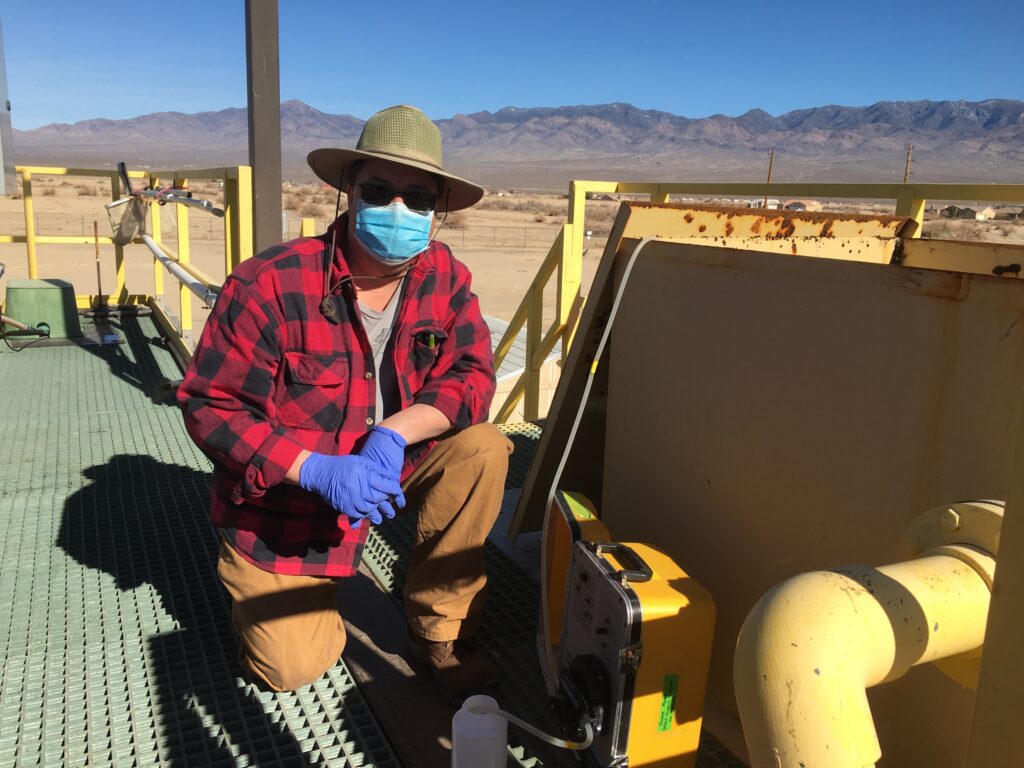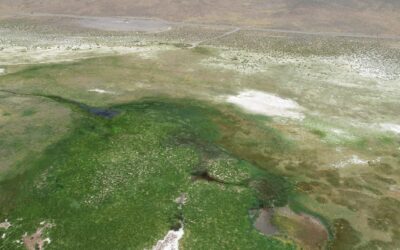The research will help public health organizations quickly predict potential outbreaks.
DRI Microbiologist Duane Moser co-authored a new study which introduces an AI-driven approach for the rapid detection and characterization of emerging variants during wastewater surveillance. The research builds on his earlier work helping to establish wastewater monitoring as a cost-effective tool for tracking pathogens during the COVID-19 pandemic.
Working with researchers from the University of Nevada, Las Vegas, Moser traveled throughout rural southern Nevada to obtain wastewater samples for the study. Published in Nature Communications, the research compared 3,659 wastewater samples collected over a 2-year period to 8,810 SARS-CoV-2 clinical genomes from Nevadans. The approach revealed differences in the timing and spatial distribution of SARS-CoV-2 variants between urban and rural wastewater systems and demonstrated rapid detection of new variants.
The new work builds upon a 2024 report by the same team, published in Environmental Science and Technology Letters, describing the timing and variant profiling of SARS-CoV-2 in unhoused populations. In support of this study, Moser sampled water from underground storm drain access portals for Tropicana and Flamingo Washes weekly for over a year.
“During the pandemic, urban wastewater surveillance proved highly effective in providing information about the timing and severity of community SARS-CoV-2 infection as progressive variants moved through the world’s urban centers,” Moser said. “In contrast, large portions of the world and U.S. represent blank spots on disease tracking maps. My role in the study was to extend the excellent analytical tools being applied in the Las Vegas metropolitan area to the much larger geographic expanse of rural Clark and Nye Counties. During the pandemic, progressive waves of SARS-CoV-2 variants moved across the land – providing a lesson in disease propagation on the landscape scale. Propagation of the pandemic, from initial appearances in urban centers to outlying areas, was almost like clockwork – typically showing a delay of 7 – 9 days. Most variants persisted in these smaller outlying populations for a week or two, only to be replaced by the next and so on. While most of the major variants first recognized in greater Las Vegas did eventually appear in the rural areas, in several cases, a given variant seemed to skip some of the more remote rural locations or perhaps came and went so quickly that our weekly sampling program missed it.”
“Overall, this study validates a growing consensus concerning the power of wastewater surveillance for disease tracking in society, including from low-density rural populations,” he added. “The new tool extends the power of wastewater surveillance to novel pathogen variants that might otherwise go undetected across large geographic expanses in the U.S. and beyond. While the pattern during the Covid pandemic was that of unidirectional outward expansion from urban-to-rural locations, as humanity continues to encroach upon Earth’s wild places, the direction of transmission could just as easily be in the other direction. Thus, wastewater surveillance of outlying areas could enable early detection of the next pandemic before it is released into one of the world’s great cities.”

Read the full news release from UNLV below:
LAS VEGAS — Wastewater surveillance became a popular choice among public health officials looking to track rapid virus mutations and spread patterns during the COVID-19 pandemic. But what if there was a way to detect emerging virus pathogens even faster — or to even sniff out new variants possibly before patients even realize they’re ill?
A new UNLV-led study is moving that dream one step closer to reality by pairing wastewater sample surveillance with artificial intelligence. The results appear in the latest issue of the journal Nature Communications.
Lead author and UNLV neuroscience graduate student Xiaowei Zhuang developed an AI-driven algorithm that scans wastewater to detect budding influenza, RSV, mpox, measles, gonorrhea, Candida auris, or other pathogen variants — often before they’re identified by clinical tests.
Scientists say being able to map virus emergence, mutation, and transmission faster with AI than with existing wastewater surveillance methods could significantly enhance public health officials’ ability to roll out rapid, targeted interventions. The tool could especially be useful in rural communities with fewer healthcare resources and residents who sometimes display testing or vaccine hesitancy.
“Imagine identifying the next outbreak even before the first patient enters a clinic. This research shows how we can make this possible,” said study co-author Edwin Oh, a professor with UNLV’s Nevada Institute of Personalized Medicine at UNLV. “Through the use of AI we can determine how a pathogen is evolving without even testing a single human being.”
“The tool could be especially useful for improving disease surveillance in rural communities”, said the Desert Research Institute’s Duane Moser, who coordinated sampling across 13 outlying wastewater plants featured in the study. “Large portions of the U.S. fall outside the jurisdiction of public health districts and thus can represent blank spots on disease tracking maps. The new tool extends the power of wastewater surveillance to novel pathogen variants which might otherwise go undetected across large geographic expanses in the U.S. and internationally”.
The research team tested its theory by analyzing nearly 3,700 wastewater samples collected from Southern Nevada waterways between 2021 and 2023. Scientists found that their AI simulation required approximately eight samples per variant to reliably establish reference signatures and as few as two to five samples per variant for the early detection of newly emerging virus strains.
Previous wastewater detection methods required prior knowledge of a variant’s genetic makeup which relied heavily on clinical data from patients who had already been tested. Though those methods worked well, they were a more reactive approach typically identifying new virus strains after they had already begun widely circulating in a community. The new method used in this study requires no prior knowledge or patient testing data, proactively detecting patterns from multiple wastewater samples.
“Wastewater surveillance has enabled more timely and proactive public health responses through monitoring disease emergence and spread at a population level in real time,” says Zhuang. “This new method enhances early outbreak detection to allow for identification of novel threats without prior knowledge, making this tool even more effective for public health surveillance moving forward.”
Since 2021, four Las Vegas institutions – UNLV, the Southern Nevada Water Authority (SNWA), the Southern Nevada Health District, and the Desert Research Institute – have collaborated on a public wastewater surveillance dashboard to track emerging cases of COVID-19 and other viruses.
The Nature Communications AI study is one of more than 30 studies these organizations, along with the Cleveland Clinic Lou Ruvo Center for Brain Health, have collaborated on. And the researchers say it’s the first to employ an AI approach in enhancing wastewater intelligence.
“Wastewater surveillance has proven to be an effective tool for filling critical data gaps and understanding public health conditions within a community,” said study co-author Daniel Gerrity, principal research microbiologist at SNWA. “The ongoing wastewater surveillance effort is a great example of how collaboration between SNWA, UNLV, and other partners can lead to positive impacts for the local community and beyond.”
More Information
“Early detection of emerging SARS-CoV-2 Variants from wastewater through genome sequencing and machine learning” was published July 8, 2025 in the journal Nature Communications.
This work was supported by funding from the Nevada Water Resources Research Institute/USGS under Grant/Cooperative Agreement No. G21AP10578 through the Division of Hydrologic Sciences at Desert Research Institute.


